The pet mullein plant
 I had never met Mullein up close until we moved to Crocker Croft. I’d seen it from afar as we drove along highways; it was quite noticeable. I remember seeing many plants of it one December as we traveled in Arizona. Near Flagstaff the tall dead plants were topped with deep caps of fresh snow; as we drew nearer to Tucson there was no more snow and they stood sere in the wintertime landscape - a landscape that was so different from my usual environments and therefore very interesting.
I had never met Mullein up close until we moved to Crocker Croft. I’d seen it from afar as we drove along highways; it was quite noticeable. I remember seeing many plants of it one December as we traveled in Arizona. Near Flagstaff the tall dead plants were topped with deep caps of fresh snow; as we drew nearer to Tucson there was no more snow and they stood sere in the wintertime landscape - a landscape that was so different from my usual environments and therefore very interesting.As Husband/Best Friend/Chief Photographer did most of the driving, I suspect he had never seen one. Even if he’d had a chance, he wouldn’t notice it - unless it had a human person attached to it in some way. For he is a people person, he doesn’t notice plants very often. Driving through the countryside anywhere on earth, he always notices the churches, the church buildings. I on the other hand, being an outdoor and plant person, always notice the cemeteries. I finally figured out why that is: Churches are groups of people; cemeteries are gardens.
Henry Mitchell, a garden writer whose work I’ve enjoyed very much, wrote that there was always mullein in the garden, then one year the gardener looks about and realizes: there’s no mullein! So, it comes and goes. A few years ago at Crocker Croft, mullein came. It came in the form of one solitary plant. A plant so large and bold the sight of it would hit even the most uninterested right between the eyes and demand to be noticed.
And, WHERE it appeared added to the wonder of it. At the head of our asphalt driveway there is a low stonewall. Where the wall and asphalt meet, there is a very slight joint. It was unbelievable that anything so wondrous could grow from such a tiny space, a crack that could hardly be seen. But, grow it did.
Husband/Best Friend/Chief Photographer’s attention was captured from the first rosette of nearly larger-than-life, soft, fuzzy gray-green leaves. Young and beautiful, frequently adorned with dew and raindrops that pearled up on the soft fuzz, it grew.
Knowing that Common Mullein is biennial, and that in normal conditions the lovely rosette would live through the winter; then come spring though ragged and tattered from winter wear, the now mature plant would grow tall, bloom, go to seed; then its life’s purpose completed, it would die - I said it probably wouldn’t make it through the winter - couldn’t have much of a root system in that tiny joint, surely not enough to support life through until spring. Humph, tough plant that mullein is, it proved me wrong. OK, well there’s no way it can amount to much come spring.
As a matter of fact, it grew, and grew, and grew until it was very noticeable and a great conversation piece. And, Chief Photographer was infatuated with a plant! It became the subject of many photographs as he documented its progress.
 | 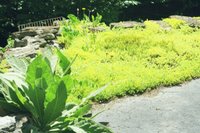 |

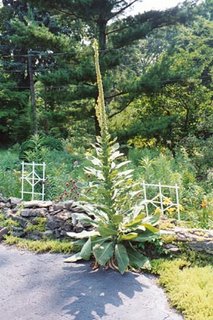 Proving me wrong yet again, the mullein that was now like a family pet began to grow. He caught me in one photo as I was talking about it, no great beauty, me, but it does give it a sense of scale. That was no dainty little plant.
Proving me wrong yet again, the mullein that was now like a family pet began to grow. He caught me in one photo as I was talking about it, no great beauty, me, but it does give it a sense of scale. That was no dainty little plant.
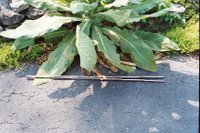
Here it's already outgrown in width a three foot measure.

 Then like Jack's Bean Stalk, it began to soar toward the sky. It bloomed, dropping small yellow blossoms that made me think of kernels of yellow corn.
Then like Jack's Bean Stalk, it began to soar toward the sky. It bloomed, dropping small yellow blossoms that made me think of kernels of yellow corn.
 He began measuring it to see how much it had grown, much in the same way we measured our children and grandchildren to document on the door-facing their growth spurts. The pet mullein soon outgrew a six-foot measuring stick - and kept growing!
He began measuring it to see how much it had grown, much in the same way we measured our children and grandchildren to document on the door-facing their growth spurts. The pet mullein soon outgrew a six-foot measuring stick - and kept growing!
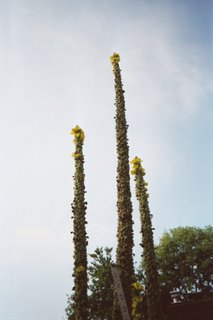
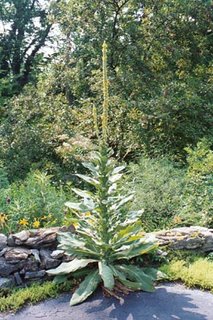
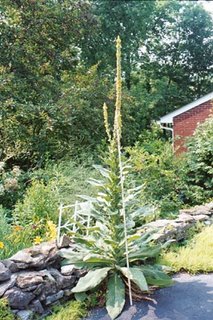


A good eight to nine feet it grew!




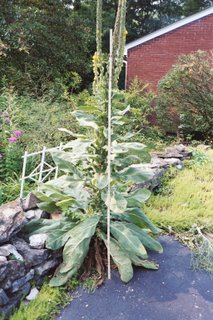
It quit growing, and yellow appeared in its fuzzy leaves.



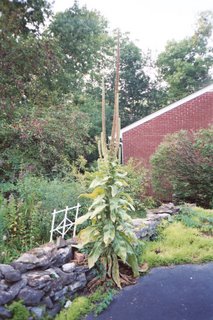 Then it started turning brown from the bottom up.
Then it started turning brown from the bottom up.



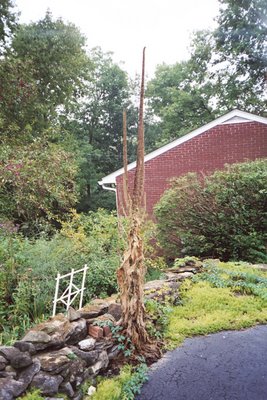 Browning, shrinking, and feeling like felt, the large leaves shrank close to the stalk enfolding it like drapery, then closer, enveloping it as if it were brown monk’s cloth closely wrapping a frail body in folds.
Browning, shrinking, and feeling like felt, the large leaves shrank close to the stalk enfolding it like drapery, then closer, enveloping it as if it were brown monk’s cloth closely wrapping a frail body in folds.



 Finally, the dark brown vertical folds clasping the base and stalk made me think of Gothic era carved figures and the linen-fold designs in Renaissance carvings of beautiful rich brown wood . It was still graceful... and, still beautiful.
Finally, the dark brown vertical folds clasping the base and stalk made me think of Gothic era carved figures and the linen-fold designs in Renaissance carvings of beautiful rich brown wood . It was still graceful... and, still beautiful.




 Frail it looked, but frail it wasn’t. The dead mullein stood all winter. By spring it looked so bad, and garish in contrast with Spring’s youth, I decided it was time for it to go. I didn’t ask, I just did it - with loppers. And, you know what, that was a very strong, woody stalk still; I thought it would be pithy and easy to cut. But no, it was woody, hard, and still well anchored in its nurturing line-thin crevice. What a wonderful plant, beautiful and endearing and entertaining. Kept us entertained for months.
Frail it looked, but frail it wasn’t. The dead mullein stood all winter. By spring it looked so bad, and garish in contrast with Spring’s youth, I decided it was time for it to go. I didn’t ask, I just did it - with loppers. And, you know what, that was a very strong, woody stalk still; I thought it would be pithy and easy to cut. But no, it was woody, hard, and still well anchored in its nurturing line-thin crevice. What a wonderful plant, beautiful and endearing and entertaining. Kept us entertained for months.Since then we have had numerous mullein plants, remember I said it produced hundreds of seeds.
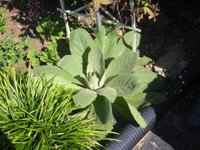
Lovely they have been, but none to equal the first one, the one we enjoyed so much. I have pulled a few, very few, seedlings. Most, I’ve let live and grow, then took them out before they went to seed. Mullein is easy to control. If you chop it, it does not re-grow from the root the way dandelions do.
Some people think that mullein is a native North American plant, but that isn’t so. It is native to Asia and Europe, and seems to have arrived in North America in the eighteenth century. Once introduced it naturalized extensively and has been labeled with many common names: Common Mullein, Great Mullein, Woolly Mullein, Flannel Mullein, Shepherd’s Club, Aaron’s Rod. Its scientific name is Verbascum thapsus.
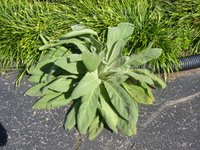
I’ve read that the Native Americans and pioneers lined their shoes and moccasins with it for warmth, insulation, and softness to protect their skin from the rubbing of handmade shoes.
My maternal grandmother told me she once had a bad spell of asthma. My grandfather went out into the farm, gathered mullein, dried it, and she, who never, ever would touch tobacco, smoked the mullein. She said she never had asthma again. I would be afraid to do such a thing; and I certainly do not recommend it. Who knows what type of allergic reaction a person could have. It’s dangerous enough with medications that have been tested repeatedly before allowed to be put on the market for sale. But back then, they didn’t have all the medications available to us today, and they certainly didn’t have the money to purchase it had it been available.
If I had to survive without modern-day knowledge, if I had to go back to the ways of my grandparents' time, could I make it? Would I be able to live the rigorous life? Now, all the mullein plants sprouting about Crocker Croft remind me of my mother’s parents, and, how much we have learned in such a few generations - and -- how much we have forgotten.
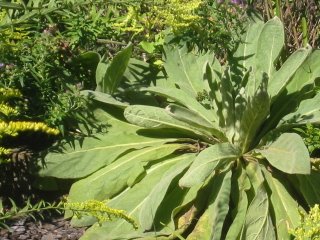


<<Back to Home Page